Learning about permaculture zones turned out to be really cool! It felt like being a child again, looking over the map of a terrain and letting your imagination run free to decide the best place for all the exciting elements we can use in permaculture: the chicken coop, fruit trees, vegetables, the compost heap, the cattle, etc.
After we got a little carried away with designing our interactive 3D map and making grandiose plans, Klaudia helped us take a step back and put things into perspective with the mind-mapping technique. This came in handy when we started thinking a little more rationally about the design for a kitchen garden (Zone 1 in permaculture) and the types of vegetables, water harvesting systems and compost location we should have close to the house (Zone 0) in this zone.
Here, we should mention that we have been eating like kings since the beginning of this PDC thanks to the cooking skills and the kindness of Hoda (Em Rabih), a lovely lady from Saidoun who has made it her mission to fill our bellies with the best she can conjure in her kitchen.
So it is with sated appetites that we once again went back to our learning discussions and the subject of the afternoon: Integrated Pest Management (IPM). When you opt for IPM, you resort to a number of strategies that replace spraying when it comes to controlling pests. The starting point is having a healthy soil and healthy plants by providing enough natural nutrients and increasing crop diversity, and, ultimately, cooking up some liquid natural pesticides.
Our friends from Saidoun and nearby Rimat joined us again for Betty's interesting demonstration of natural pesticides. Her recipe consisted of dried chili mixed with garlic or onions in water. After 24 hours of maceration, this solution should be diluted in water and sprayed over the pests attacking a plant. Afterwards, Betty explained how to start seeds in pots or planters, as well as ways of preserving seeds and labelling them.
Tomorrow we'll go into more details about water harvesting and other garden aids.
After we got a little carried away with designing our interactive 3D map and making grandiose plans, Klaudia helped us take a step back and put things into perspective with the mind-mapping technique. This came in handy when we started thinking a little more rationally about the design for a kitchen garden (Zone 1 in permaculture) and the types of vegetables, water harvesting systems and compost location we should have close to the house (Zone 0) in this zone.
Here, we should mention that we have been eating like kings since the beginning of this PDC thanks to the cooking skills and the kindness of Hoda (Em Rabih), a lovely lady from Saidoun who has made it her mission to fill our bellies with the best she can conjure in her kitchen.
So it is with sated appetites that we once again went back to our learning discussions and the subject of the afternoon: Integrated Pest Management (IPM). When you opt for IPM, you resort to a number of strategies that replace spraying when it comes to controlling pests. The starting point is having a healthy soil and healthy plants by providing enough natural nutrients and increasing crop diversity, and, ultimately, cooking up some liquid natural pesticides.
Our friends from Saidoun and nearby Rimat joined us again for Betty's interesting demonstration of natural pesticides. Her recipe consisted of dried chili mixed with garlic or onions in water. After 24 hours of maceration, this solution should be diluted in water and sprayed over the pests attacking a plant. Afterwards, Betty explained how to start seeds in pots or planters, as well as ways of preserving seeds and labelling them.
Tomorrow we'll go into more details about water harvesting and other garden aids.



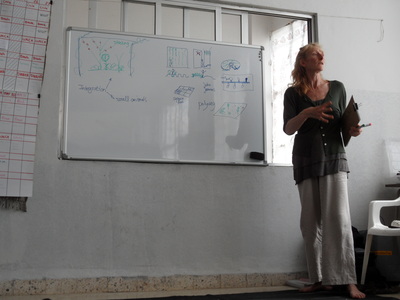
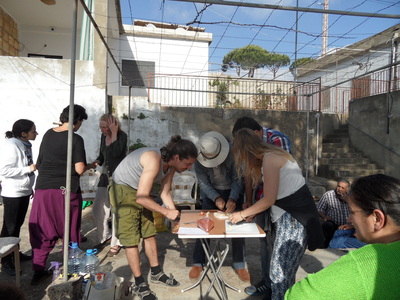

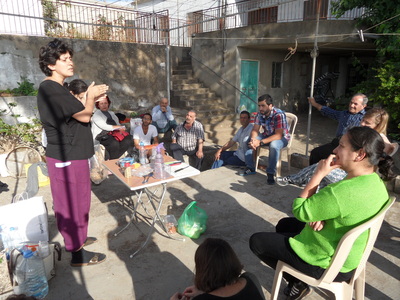
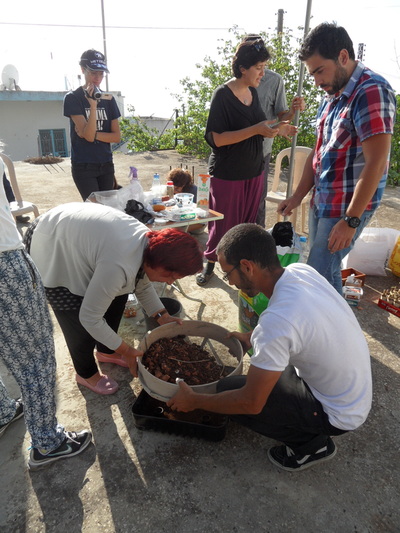
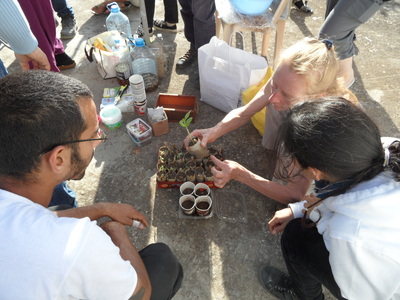

 RSS Feed
RSS Feed
